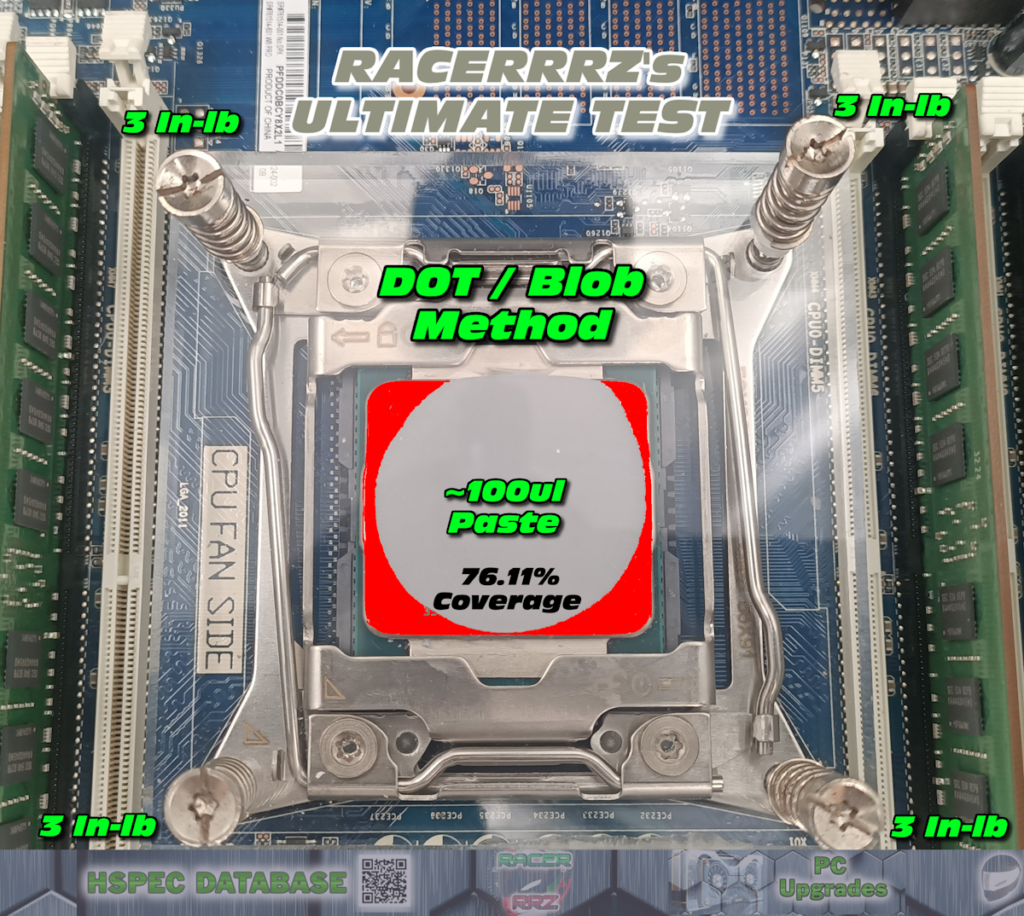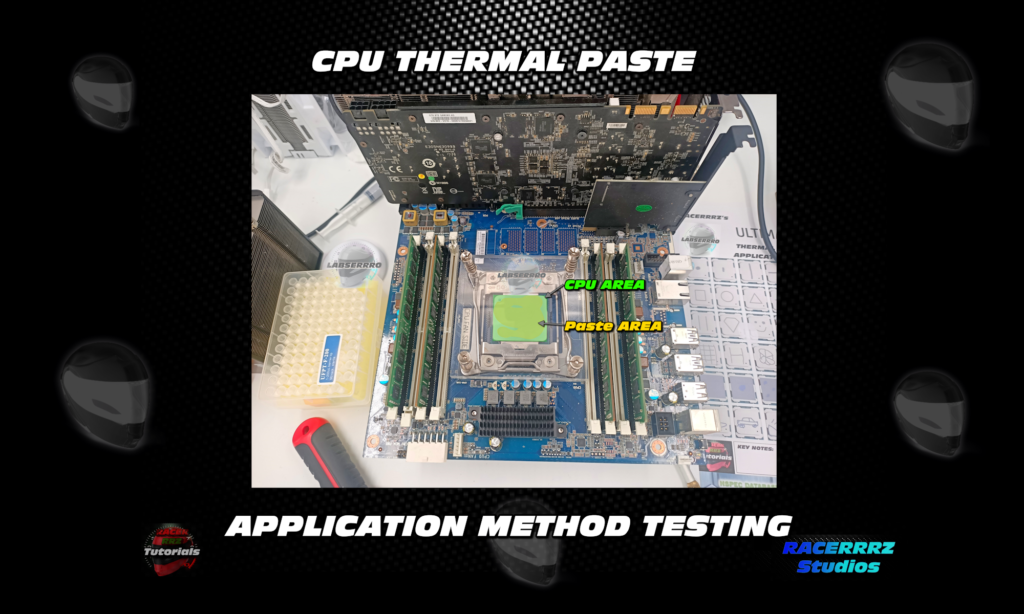RESULTS: ULTIMATE TEST
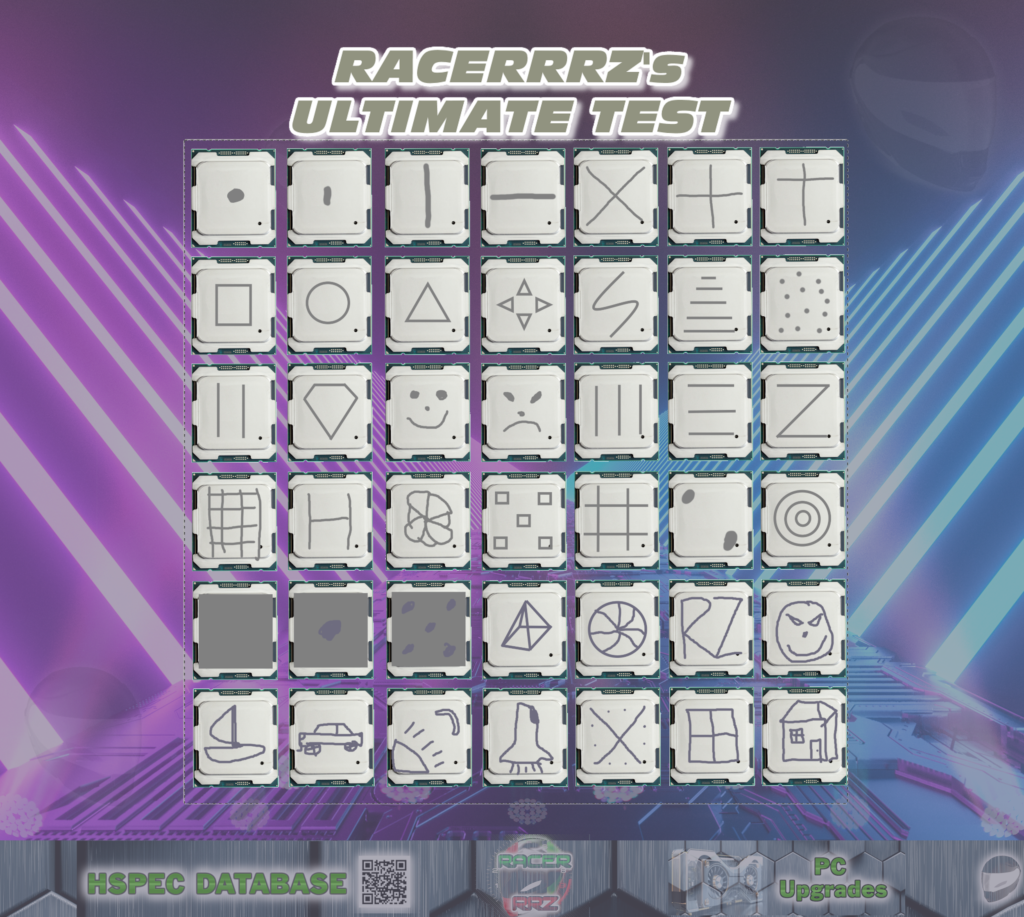
PART 1: VISUAL TESTING
PART 2: THERMAL TESTING
Table Of Contents:
Test 1: Dot
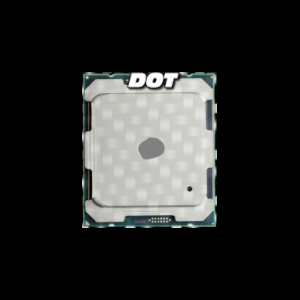
Method

Result
- Application Method: DOT METHOD
- Application Technique: Apply a small central dot on the CPU surface.
- Actual Results: Low Effort; Even spread upon mounting; ~64.22% surface area coverage.
- Common Pitfalls: Too little paste can lead to voids; excessive paste may spill over the edges.
Test 2: Rice

Method

Result
- Application Method: RICE METHOD
- Application Technique: Squeeze out elongated, rice-like lines across the center.
- Actual Results: Low Effort; Good linear spread; ~50.56% surface area coverage.
- Common Pitfalls: Inconsistent rice sizes can result in uneven coverage.
Test 3: Line Vertical
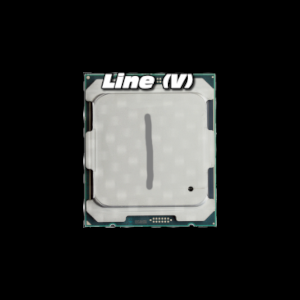
Method

Result
- Application Method: LINE METHOD VERTICAL
- Application Technique: Apply a single vertical line along the center of the processor.
- Actual Results: Low effort; Creates a focused spread along the length; ~53.08% surface area coverage.
- Common Pitfalls: Misalignment may leave edge areas lacking paste.
Test 4: Line Horizontal

Method

Result
- Application Method: LINE METHOD HORIZONTAL
- Application Technique: Draw a horizontal line across the center.
- Actual Results: Low effort; Yields good midsection coverage with ~51.35% surface area coverage.
- Common Pitfalls: Edges may remain under-coated if the line is too narrow.
Test 5: X-Pattern

Method

Result
- Application Method: PATTERN X METHOD
- Application Technique: Apply two overlapping lines in an “X” formation.
- Actual Results: Medium effort; Encourages a more uniform spread; ~64.57% surface area coverage.
- Common Pitfalls: Excess paste at the center can lead to spillage if not applied evenly.
Test 6: Plus

Method

Result
- Application Method: PLUS METHOD
- Application Technique: Apply a cross-like “+” shape centered on the die.
- Actual Results: Medium Effort; Results in balanced spreading with about ~76.66 surface area coverage; nearly full central coverage.
- Common Pitfalls: Inaccurate centering can reduce spread efficiency along the diagonals.
Test 7: Cross

Method

Result
- Application Method: CROSS METHOD
- Application Technique: Use two intersecting lines that create a cross, rotated relative to the CPU edges.
- Actual Results: Medium effort; Achieved ~56.79% surface area coverage.
- Common Pitfalls: Overlap in the center can lead to thicker paste buildup on one side of IHS.
Test 8: Square
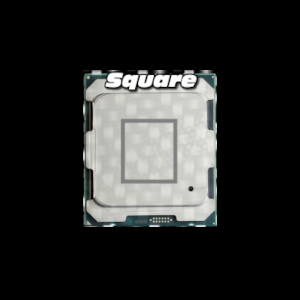
Method

Result
- Application Method: SQUARE METHOD
- Application Technique: Form a small square block covering the center area.
- Actual Results: Medium effort; Provides a controlled spread with ~76.68% surface area coverage.
- Common Pitfalls: Edges of the square may not fully extend to the corners; Air-gap over center.
Test 9: Circle

Method

Result
- Application Method: CIRCLE METHOD
- Application Technique: Apply a circular blob in the center.
- Actual Results: Medium effort; Even radial spread; efficiency ~66.68% surface area coverage.
- Common Pitfalls: The size of the circle must be carefully controlled to avoid under- or over-application; Large air-gap in IHS center.
Test 10: Triangle

Method

Result
- Application Method: TRIANGLE METHOD
- Application Technique: Form a triangular shape centered on the CPU.
- Actual Results: Medium effort; Yields a directional spread with ~69.31% surface area coverage.
- Common Pitfalls: Uneven triangle angles may leave corners less coated; May have central air pocket.
Test 11: 4x Buttons

Method

Result
- Application Method: FOUR BUTTONS METHOD
- Application Technique: Place four small dots (like buttons) at equal distances from the center.
- Actual Results: High effort; Encourages multi-directional spread; efficiency ~62.68% surface area coverage.
- Common Pitfalls: Misplacement of dots can result in uneven pressure distribution; May result in central air-gap.
Test 12: Letter S

Method

Result
- Application Method: LETTER S METHOD
- Application Technique: Apply paste in an “S” shape that winds across the surface.
- Actual Results: Medium effort; Provides an irregular but effective spread; Roughly ~69.23% surface area coverage.
- Common Pitfalls: Complex pattern increases the risk of uneven thickness in tight curves; May have two central air-gaps.
Test 13: Bee Hive

Method

Result
- Application Method: BEE HIVE METHOD
- Application Technique: Create a pattern of multiple small tapering hexagonal deposits mimicking a beehive.
- Actual Results: Medium effort; Encourages a multi-point spread; efficiency ~57.96% surface area coverage.
- Common Pitfalls: Over-complicating the pattern can lead to unintentional pooling in the center; May have large air-gaps between lines.
Test 14: Random Dots

Method

Result
- Application Method: RANDOM DOTS METHOD
- Application Technique: Distribute several small dots randomly across the CPU.
- Actual Results: Medium effort; Spread is unpredictable; efficiency may vary; ~71.33% surface area coverage.
- Common Pitfalls: Inconsistent placement can leave cold spots or cause excess in some areas.
Test 15: Two-Lines Vertical

Method

Result
- Application Method: TWO LINES VERTICAL METHOD
- Application Technique: Apply two parallel vertical lines along the CPU surface.
- Actual Results: Medium effort; Provides focused central coverage with ~30.63% surface area coverage.
- Common Pitfalls: Lines too far apart may leave uncoated margins; Proved highly inconsistent – Avoid!
Test 16: Diamond

Method

Result
- Application Method: DIAMOND METHOD
- Application Technique: Form a diamond shape in the center of the CPU.
- Actual Results: Medium effort; Directs the paste outward in a controlled manner; efficiency 71.14% surface area coverage.
- Common Pitfalls: Sharp corners can concentrate paste and create hot spots if misaligned; Leaves large central air-gap.
Test 17: Happy Smiley
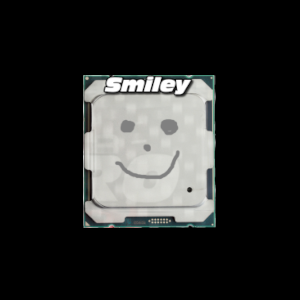
Method

Result
- Application Method: HAPPY SMILEY FACE METHOD
- Application Technique: Arrange the paste to form a basic smiley face pattern.
- Actual Results: Medium effort; Novel pattern with good radial spread; efficiency ~83.3% surface area coverage.
- Common Pitfalls: Decorative patterns may sacrifice optimal coverage if not sized correctly.
Test 18: Angry Smiley

Method

Result
- Application Method: ANGRY SMILEY FACE METHOD
- Application Technique: Create a frowning face pattern with accentuated “eyebrows”.
- Actual Results: Medium effort; Results in a slightly uneven spread; efficiency ~68.29% surface area coverage.
- Common Pitfalls: Extra paste in the “eyebrow” areas may lead to over-application; central edges left lacking paste.
Test 19: Three-Lines Vertical
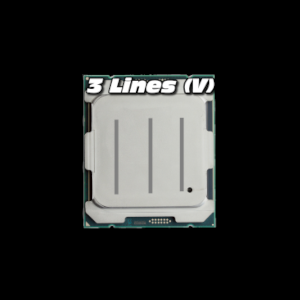
Method
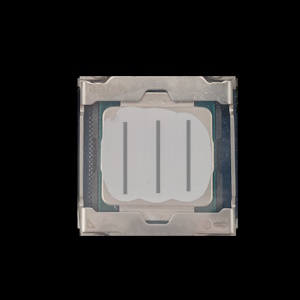
Result
- Application Method: THREE LINES VERTICAL METHOD
- Application Technique: Apply three evenly spaced vertical lines.
- Actual Results: Medium effort; Offers detailed directional control; efficiency ~83.82% surface area coverage.
- Common Pitfalls: Insufficient paste leads to large air-gaps; Proved highly inconsistent – excess paste helps avoid pitfalls.
Test 20: Three-Lines Horizontal

Method

Result
- Application Method: THREE LINES HORIZONTAL METHOD
- Application Technique: Lay down three parallel horizontal lines across the CPU.
- Actual Results: Medium effort; Encourages an even lateral spread; efficiency ~62.49% surface area coverage.
- Common Pitfalls: Uneven spacing may cause some areas to be over or under coated; Proved highly inconsistent.
Test 21: Letter Z
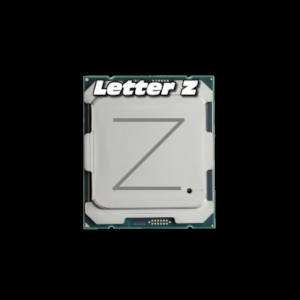
Method

Result
- Application Method: LETTER Z METHOD
- Application Technique: Draw a “Z” shape starting at one corner and ending at the opposite.
- Actual Results: Medium effort but high volume; Creates directional flow with ~80.68% surface area coverage.
- Common Pitfalls: The diagonal portions may not spread evenly if too thin; Best to apply excess paste to avoid air pockets.
Test 22: Grid

Method

Result
- Application Method: GRID METHOD
- Application Technique: Form a grid-like pattern of intersecting lines.
- Actual Results: High effort; Results in very uniform spread; efficiency ~78.09% with effective IHS coverage.
- Common Pitfalls: Overly complex grids can trap excess paste at intersections.
Test 23: Letter H

Method

Result
- Application Method: LETTER H METHOD
- Application Technique: Apply paste in the shape of an “H” across the surface.
- Actual Results: Medium effort; Provides structured spread with approximately ~58.66% surface area coverage.
- Common Pitfalls: Inaccurate alignment can lead to under-coating at the vertical bars.
Test 24: Wheel

Method

Result
- Application Method: WHEEL METHOD
- Application Technique: Create a central hub with radiating “spokes” resembling a wheel.
- Actual Results: High effort; Offers multi-directional spread in a circular shape; efficiency ~68.05% coverage.
- Common Pitfalls: Spoke gaps can occur if the pattern isn’t symmetrical; Leaves IHS edges without paste.
Test 25: Four Squares

Method

Result
- Application Method: FOUR SQUARES METHOD
- Application Technique: Place four small square blobs at each quadrant of the CPU.
- Actual Results: Medium effort; When compressed, these should merge to ~68.67% surface area coverage.
- Common Pitfalls: Poor quadrant spacing may lead to uneven paste distribution and large air pockets.
Test 26: Tic-Tac-Toe

Method

Result
- Application Method: TICK TAC TOE METHOD
- Application Technique: Apply paste in a tic-tac-toe (noughts and crosses) formation.
- Actual Results: Medium effort; Provides a balanced network spread; efficiency ~54.15% surface area coverage.
- Common Pitfalls: Overlapping intersections may result in thicker paste layers; Created an air gap in the middle.
Test 27: Spreader

Method
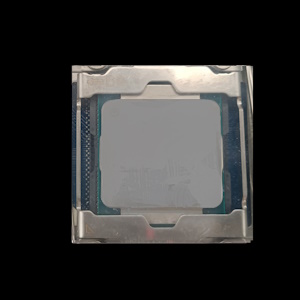
Result
- Application Method: SPREADER METHOD
- Application Technique: Use a dedicated spreader tool to evenly distribute a thin layer across the surface.
- Actual Results: High effort; Achieves excellent uniformity with ~72.67% surface area coverage – calculated from perspex block’s print.
- Common Pitfalls: Over-spreading or thin application can lead to scraping gaps; Tool must be clean and smooth; May leave air-pockets in thin areas.
Test 28: Spreader + Five Dots

Method

Result
- Application Method: SPREADER WITH FIVE DOTS METHOD
- Application Technique: Combine a light spreader application with five strategic dots (one center and four corners).
- Actual Results: High effort; Maximizes spread efficiency to ~76.07% surface area coverage – calculated based on perspex block’s pattern.
- Common Pitfalls: May leave air gaps; Coordination between tool and dots is critical; Misalignment can cause uneven layers.
Motherboard Socket Failure – Concludes Visual Test
Test 29: Two-Dots
Method
Result
- Application Technique: Place two medium-sized dots symmetrically on the surface.
- Actual Results: Expected to provide a decent spread but with coverage lacking in opposite aspects.
- Common Pitfalls: Too wide a gap between the dots may leave uncoated regions.
Test 30: Many Circles
Method
Result
- Application Technique: Apply multiple small circular dots across the CPU in a loose pattern.
- Actual Results: Expected to produce a large uniform circle.
- Common Pitfalls: May produce edges that lack thermal paste coverage.
Test 31: Spreader + Dot
Method
Result
- Application Technique: Use a spreader for an even base and then add a central dot to boost the paste volume.
- Actual Results: Expected to achieve an efficient uniform spread.
- Common Pitfalls: Risk of over-application at the center if the dot is too large.
Test 32: Pyramid
Method
Result
- Application Technique: Apply the paste in a pyramid (triangular) mound, thicker at the center.
- Actual Results: Expected to produce a triangular coverage pattern.
- Common Pitfalls: Excess thickness in the center may lead to uneven paste distribution.
Test 33: Vortex
Method
Result
- Application Technique: Create a swirling vortex pattern that spirals outward from the center.
- Actual Results: Encourages a natural outward flow.
- Common Pitfalls: Inconsistent swirl can trap air or create uneven coverage.
Test 34: Letters RZ
Method
Result
- Inspiration: Inspired by RACERRRZ. Called the “Initial Method”.
- Application Technique: Form the letters “R” and “Z” with the paste on the CPU surface.
- Actual Results: Novel pattern with likely efficient spread.
- Common Pitfalls: Artistic patterns may not translate to optimal thermal performance if mis-sized; May leave an air-gap in the middle of IHS.
Test 35: Full Face
Method
Result
- Application Technique: Draw a full face to cover the entire CPU surface with a thin, uniform layer of paste.
- Actual Results: High effort; Yields decent coverage when properly applied.
- Common Pitfalls: Risk of excess paste leading to leakage beyond the CPU edges; May not cover IHS edges.
Test 36: Sail Boat
Method
Result
- Application Technique: Apply paste in a curved “sail boat” shape, mimicking a boat’s shape.
- Actual Results: Provides directional flow with decent efficiency.
- Common Pitfalls: Curvature must be smooth; uneven curves can leave gaps; May leave one quadrant devoid of paste.
Test 37: Car
Method
Result
- Application Technique: Create a pattern reminiscent of a car silhouette with defined “wheels” and “body”.
- Actual Results: High effort; Novel pattern with expected good coverage across IHS center.
- Common Pitfalls: Over-detailed designs may compromise uniform spread; Lack of coverage on upper and lower margins.
Test 38: Sun and Moon
Method
Result
- Application Technique: Apply two contrasting shapes – a circular “sun” and a crescent “moon”.
- Actual Results: High effort; Produces an interesting dual-spread with overall efficiency expected to be decent.
- Common Pitfalls: Balancing two distinct areas may lead to localized excess paste or air pockets.
Test 39: Rocket
Method
Result
- Application Technique: Form a rocket shape with a tapered body and pointed tip centered on the die.
- Actual Results: This one is sure to blast off into fame; Expected to leave most of the IHS covered.
- Common Pitfalls: The pointed tip may lead to localized paste accumulation if not carefully applied; May leave upper margin without sufficient coverage.
Test 40: Letter X + Dots
Method
Result
- Application Technique: Apply a central “X” shape with additional small dots at each arm’s end.
- Actual Results: Offers a multi-directional spread pattern with expected high coverage efficiency.
- Common Pitfalls: Extra dots can lead to excess paste if not proportioned correctly.
Test 41: Window
Method
Result
- Application Technique: Arrange paste in a rectangular frame mimicking a window outline.
- Actual Results: Provides consistent edge-to-center spread; Likely with decent IHS coverage.
- Common Pitfalls: The inner “pane” may be under-coated if the frame is too thick.
Test 42: House
Method
Result
- Application Technique: Form a simple house shape – a square with a triangular “roof”.
- Actual Results: When compressed, the design encourages a balanced spread while retaining the pattern’s integrity.
- Common Pitfalls: The roof section can lead to excess paste if its dimensions are not carefully maintained.
Data Graphs:
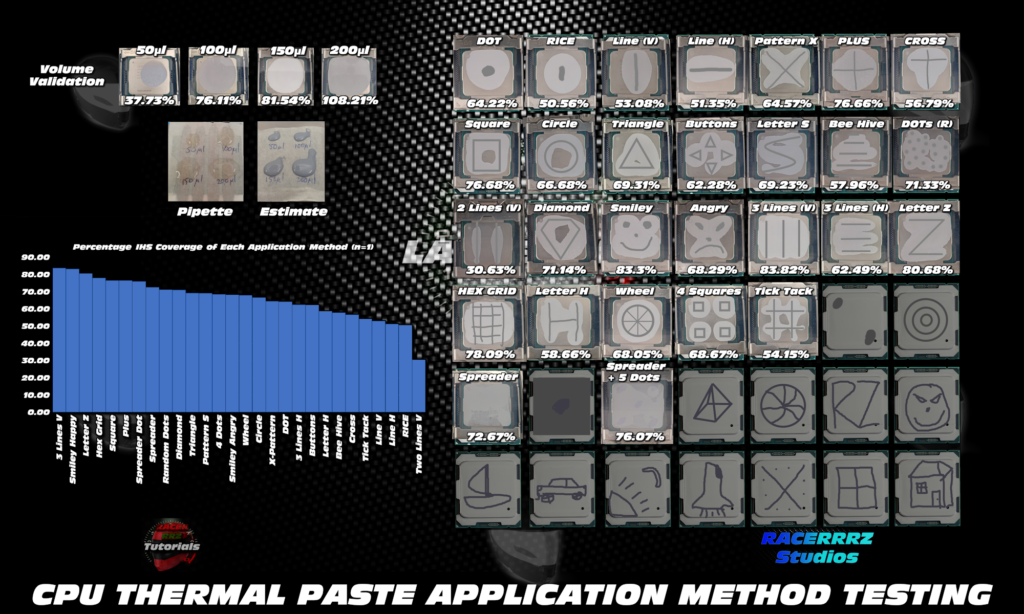
Visual Testing Results:
Top 5 Methods (in order of best to worst):
Happy Smiley : Letter Z : Hex Grid : Square : Plus
Caveats: 3 Line method super inconsistent. Spreader methods tested last – CPU socket had failed leaving one corner not clamping sufficiently.
Worst 5 Methods (in order of best to worst):
Cross : Tick Tack Toe : Line vertical : Rice : Two Lines Vertical
Caveats: Two line method application volume may have been too low; regardless – a very inconsistent method.
All results are n = 1; with only one trial having been done. Given the nature of the result this may not matter. This serves as a visual screen for isolating the best methods for further testing. Ideally 3 replicates would be done for consistency. More consistent paste volume application would be critical for fair testing.
Method: The Test Rig
- HP Z440 motherboard with LGA 2011-v3 socket – same Haswell Xeon CPU (did show wear from repeated application testing).
- One stock of thermal paste – HY500 Thermal Grease from Halnziye (100g volume). Not expected to be efficient but that helps with identifying poor application methods.
- A clear acrylic perspex plastic – 10mm, 100X100mm – was used to visualize paste spread efficiency. Perspexs did show wear from successive application of thermal paste and removal.
- Attempt to control the thermal paste volume (with 150ul being identified as ideal for a Haswell Xeon CPU for ~70 – 80% IHS coverage).
- An even amount of CPU-to-acrylic pressure of 3 lb-in on all four mounting bolts (measured with VANPO digital torque screwdriver).
- A reference volume of paste to estimate the volume. Accurate pipetting of viscous fluids like thermal paste is difficult. Water pipetting was used as visual confirmation of viscous volume estimations.
- Realistically the volume will not be accurately controlled in this visual test which will limit the usefulness of the outcome; but every effort was made to be consistent.
- Only one replicate of each pattern will be tested – mostly due to time efficiency – which does create the potential for measurement bias.
- Data analysis was done using ImageJ. Total IHS surface area was traced and pixel count determined. Then total visible IHS coverage (or perspex block coverage if more appropriate) was used to calculate surface coverage. Surface area / Total Area * 100% produced the data displayed for visual estimation of surface area coverage.
